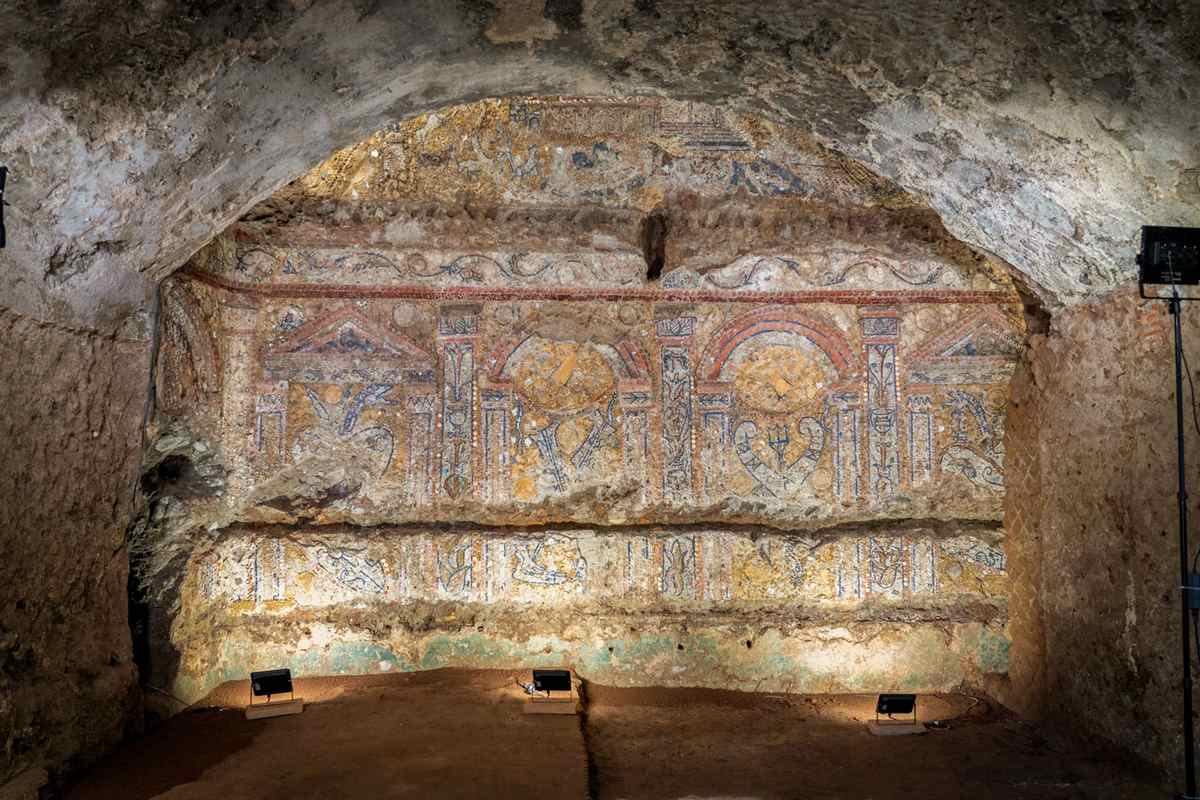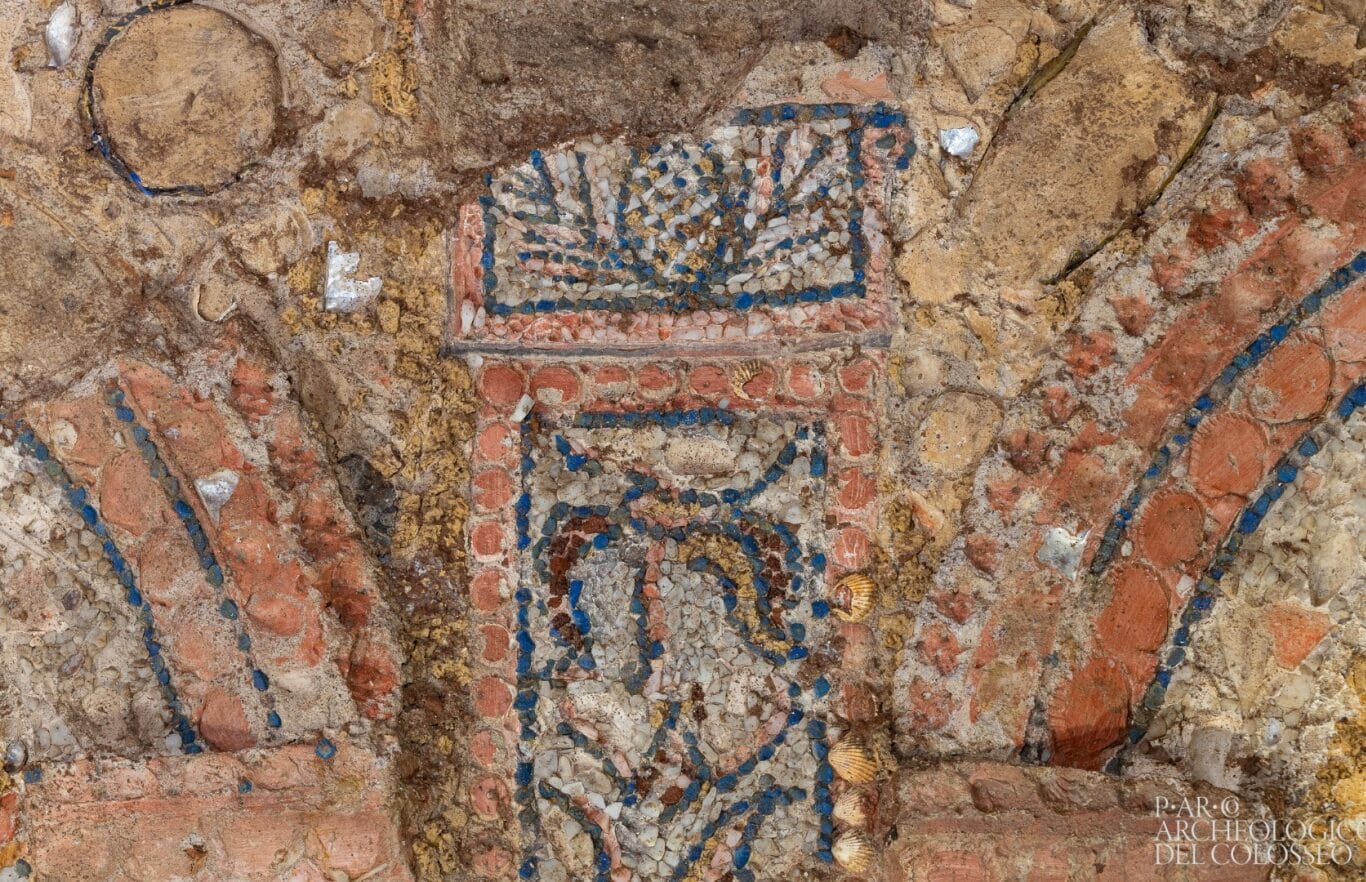In a remarkable feat of archaeological exploration, a five-year dig into the Palatine Hill in Rome has yielded a stunning discovery – a deluxe banquet room dating back to the first or second century BC, featuring an exquisite, intact, and brightly colored wall mosaic. This astounding find, estimated to be around 2,300 years old, is part of a larger aristocratic mansion located near the Roman Forum, which has been under excavation since 2018.

A Mosaic of Grandeur and Celebration
The mosaic, measuring almost five meters in length (16.4 ft), is a true masterpiece of ancient craftsmanship. Adorned with depictions of vines, lotus leaves, tridents, trumpets, helmets, and mythological marine creatures, the scene was painstakingly created using a dazzling array of materials, including mother of pearl, shells, corals, shards of precious glass, and flecks of marble. The piece is framed by polychrome crystals, spongy travertine, and exotic, ancient Egyptian blue tiles, creating a truly mesmerizing visual display.
Uncovering the Secrets of the Past
What makes this discovery particularly remarkable, according to archaeologist Alfonsina Russo, head of the Colosseum Archaeological Park, is not only the incredible preservation of the mosaic but also its decoration, which features celebratory scenes of naval and land battles. These scenes were likely commissioned and commemorated by an extremely wealthy aristocratic patron, revealing the opulence and high social status of the property’s former occupants.

A Glimpse into the Luxurious Lifestyle of the Roman Elite
The discovery of this banquet hall, measuring 25 square meters (270 square feet), is just one part of the larger “domus” (the Latin word for house) that has been uncovered. In ancient times, when powerful noble families inhabited the Palatine Hill, the use of rich decorative elements, such as this intricate mosaic, was a symbol of their wealth and high social rank. The chamber was an outdoor banquet hall overlooking a garden, likely used during the summer to entertain guests, and may have even featured water games, a popular pastime among the Roman nobility.

Preserving the Fragility of the Past
The remarkable preservation of this mosaic is a testament to the protective power of the earth. Being buried under the Palatine Hill has shielded this delicate artwork from the elements for centuries, preventing it from being damaged by the weight of debris or the effects of air and light. Archaeologists believe that the location of the grand home, positioned on the side of the Palatine Hill and subsequently covered in layers of mud and earth, has been instrumental in preserving this incredible treasure.
Unveiling More Secrets
As the excavation continues, archaeologists are working to uncover more of the secrets hidden within this ancient Roman mansion. They are exploring the possibility of identifying the noble family that once occupied this lavish property, based on the wealth and opulence displayed in the mosaic and other artifacts found on the site. The discovery of this remarkable banquet hall and its stunning mosaic has shed new light on the luxurious lives of the Roman elite and has captured the imagination of scholars and the public alike.
The Enduring Power of Archaeology
The discovery of this exquisite mosaic-adorned banquet hall on the Palatine Hill in Rome is a testament to the enduring power of archaeology to uncover the secrets of the past. This remarkable find not only showcases the breathtaking artistry and craftsmanship of ancient Rome but also provides a glimpse into the lavish lifestyles of the Roman aristocracy. As the excavation continues, the team of archaeologists is poised to unlock even more of the mysteries hidden within this extraordinary site, further enriching our understanding of one of the most iconic civilizations in human history.




